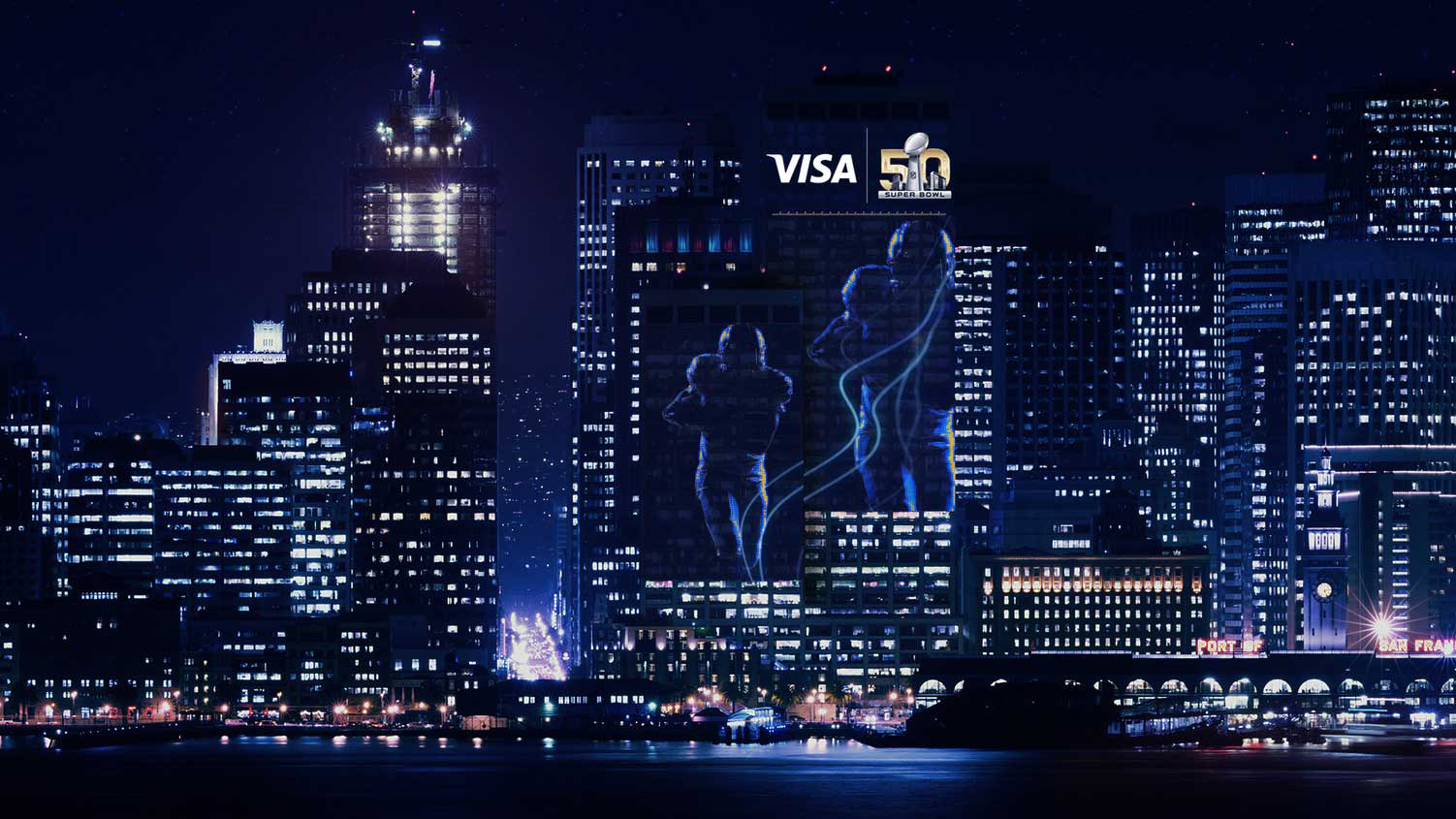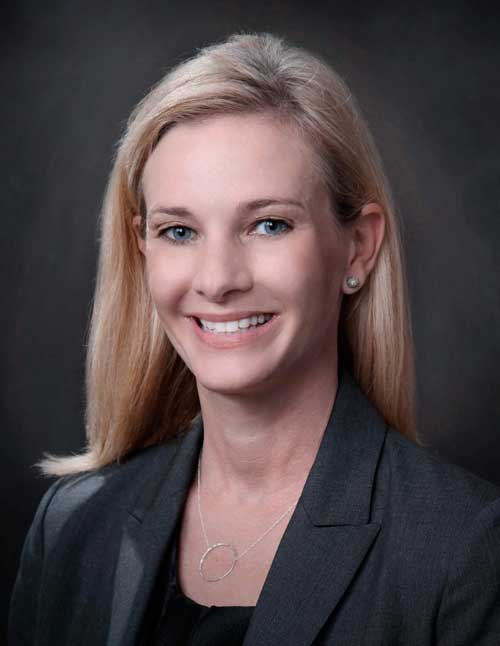Visa’s story: When digital transformation begs for organizational change
Contributors Nadine Dietz and Erica Seidel interview Visa's North American marketing chief and discover how she cultivates "human Swiss Army knife" talent.

Visa Digital Skyline in downtown San Francisco for SuperBowl 50.
When you think of Visa, what comes to mind? Plastic credit cards? A hierarchical financial services culture? Think again.
Visa has gone through tremendous change to meet consumers where they are — on their mobile devices. There’s more to this change than paying on mobile rather than plastic.
The organization considers itself more of a technology company than a financial services company. The marketing leadership at Visa reinvented not just the way they engage consumers, amidst an onslaught of social channels, but also how the team is organized.
The marketing team made an intentional organizational shift from vertical to horizontal and has home-grown an army of “Swiss Army knife” talent.
Leading this effort for North America Marketing is Lara Hood Balazs. She joined us to discuss how this organizational change happened, and how it has given rise to new digital business solutions and a workforce that promotes equality and diversity.
Q. What did your organization look like before?
We were set up like a traditional brand management organization. For each product, there was one person who owned marketing, including all aspects of the go-to-market strategy across all channels (print, digital, TV, etc.)
Separate from marketing, we had Product, IT, Legal and Risk functions. This led to a lot of silos across the organization.
Q. What caused you to think differently about how you were organized?
We used to look at paid, earned and owned media as three separate buckets. But consumers don’t think that way. Information coming to you in vertical buckets simply causes confusion.
In addition, we were moving too slowly to launch digital products, and our information management was highly fragmented. We knew we needed to reorganize according to how the consumer actually consumes information, and in real time.
Q. What changes did you make?
First, I took out two to three layers in the organization and blended the teams so that people didn’t work on a specific product line. Everyone started working across multiple products and across multiple channels.
Now everything is done in project-based teams to increase collaboration. We still have distinct groups for our two main stakeholders: consumers and clients.
But now the flow of work and information is horizontal rather than vertical, and projects include key members of other functions outside marketing, such as Legal, Product, IT and Risk Management.
Q. That’s a pretty big leap. How did the organization react?
The biggest change was cultural. We were very straightforward about the need for change and promoted the benefits of removing guardrails from the workday, taking on stretch roles that expand your resume and generally asking the team to get comfortable with the many shades of gray.
We let the teams know that this would be an immediate change; we had to make a big transition because our consumers required it of us. Essentially, we ripped the Band-Aid off and set out to support this blended team structure where everyone has a voice and anyone’s idea could be implemented.
Q. How did you support and grow the talent on your team to operate in this new world?
We assigned each team member a mentoring manager to help cultivate the skills they needed to advance their careers. We explained that a project-based world is like baseball. You have a home base — a manager that you report to who helps you navigate your career, but you have this flex time to run the bases.
And together as a team, we all took on the “human Swiss Army knife” behavior. That behavior means operating without a playbook and looking at the world as if you were the consumer, to come up with the right solutions regardless of your function.
Experimenting with social media was a big part of this. We have a monthly meeting called #InnovationKorner, when team members share a new app, trend or technology they discovered the week before.
Q. What happened once you put this change into effect?
We immediately saw great ideas coming together, with new thinking and diversity coming to the table.
For instance, in the early days of the new organization, someone came to #InnovationKorner excited to explore Pinterest further. We ended up developing a new concept for Pinterest and Gymboree using animated posts (Activate the animation below by clicking the overlay that says “GIF”).
It led to a lift in sales for Gymboree. Another team member inspired us to develop shoppable videos for Williams-Sonoma on YouTube.
As a partner with the NFL, we just launched a new suite of digital capabilities at SuperBowl 50. This included 600 upgraded POS locations in the arena for easy payment, drinks delivered to your seat from your mobile phone, offers while you travel with Uber, and the Visa Digital Skyline in downtown San Francisco.
This required a tiger team of individuals from sponsorship and multiple people from our product groups, but it was led by our fearless team of marketers.

Visa headquarters in San Francisco.
Q. What successes have you seen from an organization or talent perspective?
Employees say they feel more empowered and the team has a very high employee retention rate — a rarity in the Bay Area!
We are a much more fluid, supportive team that works exceptionally well together for the benefit of the consumer. Given that everyone on the team is equally important, this leads to gender equality across the ranks.
In fact, given that so many of our consumers are female, it’s that much more important to have strong women at Visa determining how we go to market.
Having said that, there are always some growing pains when you implement change. And, as the world of payments and technology continues to evolve at a rapid pace, this team needs to continually challenge the status quo and be ready to pivot as the environment dictates.
It’s why the concept of a “Swiss Army knife” works for us, but we still need to work at it and assess our strategy to ensure a happy and healthy team.
Q. Example of a superstar employee and their career path?
One of our marketing directors is a great example of how this flat organization has worked. Under the new project-based organization, she came up with a “#footballentinesday” campaign for our Visa Checkout partner, 1-800-Flowers.
This campaign drove net new flower sales during football season, which is traditionally a slower time for flower sales. She went on to lead marketing for the launch of Visa and Android Pay in the United States. She also helped drive a pilot program with Chevron, educating consumers on how to use their mobile device at the pump to pay, using a video starring one of Visa’s athletes, Carli Lloyd.
These activations are a big reason Visa made the list of the BizBash Top Ten Innovative Brands. We were number three, just behind Nike and Samsung. She went on to negotiate a major Olympics partnership. In the new organization, her engagement and exposure have really risen. She has since gotten promoted.
Q. So now that you’ve home-grown an army of human Swiss Army knives, how do you bring new people into the team? What do you look for in candidates?
We look both at their career path and at their outside interests to be sure they are a fit and can operate in shades of gray, and that they get excited by that!
From a career path perspective, we look for diversity in roles. We look for people who’ve worked in organizations that aren’t rigid — people who thrive when everything is not solved for them.
We explore their outside interests to ensure they get how our consumers think. Are they on Facebook, Instagram, Snapchat? What do they enjoy?
Final word from Lara Hood Balazs:
“Visa stands for ‘Everywhere you want to be.’ That is more than just a physical manifestation. It’s also about acceptance, diversity and equality.”
In our Driving the Modern Marketing Organization column, we’re profiling top marketers who are (re)organizing their marketing teams to fulfill their modern marketing mandate. What do you think? And who else would you like to nominate for a profile? Email us or reach us on social media and let us know your thoughts.
Opinions expressed in this article are those of the guest author and not necessarily MarTech. Staff authors are listed here.
Related stories
